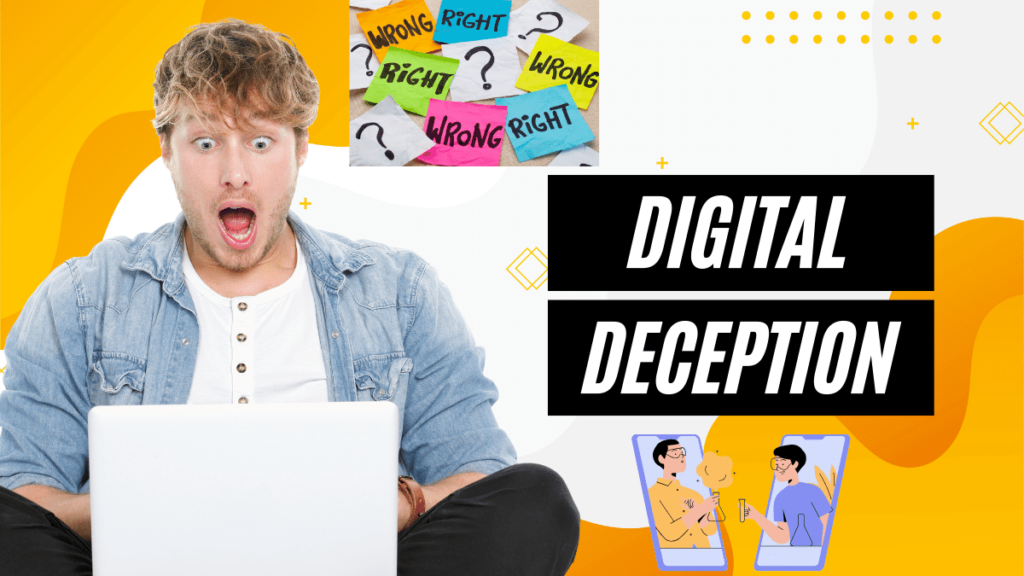In the age of digital communication, where information spreads rapidly across the internet, the issue of digital deception has become increasingly prevalent. Whether through social media platforms, dating apps, or online forums, the digital world is full of falsehoods—some intentional and some unintentional. But why do people lie online? When does digital deception occur? And how do people create and propagate these lies?
In this article, we will delve into the phenomenon of digital deception, examining its causes, forms, and consequences. We will also explore practical tips on how to recognize and protect oneself from digital deception, offering a comprehensive view of this complex issue.
What is Digital Deception?
Digital deception refers to the act of intentionally or unintentionally providing false, misleading, or incomplete information in an online context. This could occur in a variety of ways, such as misrepresenting one’s identity, posting fake news, exaggerating experiences, or manipulating online interactions for personal gain.
While digital deception may not always have malicious intent, it often leads to misunderstandings, distrust, and significant consequences in both personal and professional contexts. The proliferation of digital platforms and the relative anonymity they offer has made it easier for people to engage in deceptive behaviors online.

The Psychology Behind Digital Deception
To understand why people lie online, it’s important to consider the psychological factors at play. The reasons behind digital deception are diverse, but common psychological drivers include:
- Anonymity: The anonymity of the internet allows individuals to create alternate identities, often with fewer immediate consequences than in face-to-face interactions. This reduces social inhibitions, making people more likely to lie.
- Social Comparison: Many individuals feel compelled to present a curated version of their lives on social media. This often leads to exaggerating achievements or manipulating images to create a more idealized persona.
- Self-Presentation: People are often motivated by the desire to present themselves in a favorable light. Digital platforms, particularly social media, provide ample opportunities for self-presentation, which sometimes involves crafting false narratives.
- Social Influence: When people see others lying online (e.g., exaggerated success stories or manipulated images), they may feel pressured to follow suit in order to fit in or gain social validation.
- Convenience: Digital deception can be a convenient way to avoid uncomfortable situations or to manipulate outcomes without having to face immediate consequences.
Types of Digital Deception
Digital deception manifests in various forms. Some of the most common types include:
1. Identity Manipulation
- Catfishing: One of the most notorious forms of online deception, catfishing involves creating a fake identity to deceive others, often for romantic or financial gain. A person might use stolen photos, fake names, and fictitious details to manipulate someone into developing a relationship.
- Fake Profiles: Users on platforms like LinkedIn, Instagram, or Facebook may create profiles that are either completely fabricated or heavily altered, including fake job titles, achievements, and photos.
2. Exaggeration and Misleading Content
- Curated Social Media Lives: Social media platforms encourage users to post highlight reels of their lives—focusing on successes, vacations, or personal milestones. This selective sharing can create unrealistic perceptions, leading others to believe that these moments are more frequent or significant than they are in reality.
- Fake Testimonials or Reviews: Brands or individuals may post fabricated reviews to bolster their reputation, either by exaggerating positive feedback or posting fake negative reviews about competitors.
3. Misinformation and Disinformation
- Fake News: The spread of false or misleading information, often with a political or social agenda, has become a significant issue. These types of deceptions are particularly harmful because they can shape public opinion and influence elections.
- Manipulated Photos and Videos: Deepfakes and image manipulation tools allow individuals to create realistic but fake content. For example, a photo of a celebrity might be altered to show them in an inappropriate context, spreading misinformation.
4. Misleading Advertisements and Clickbait
Clickbait: Headlines designed to entice users to click on an article or video by promising sensational content, but often leading to something less relevant or interesting.
Deceptive Advertising: Online ads often use deceptive tactics to draw in consumers, such as making unrealistic claims about products or services.

When Does Digital Deception Occur?
Digital deception can happen in various online contexts, including:
- Social Media: Whether through curated images or false claims, social media is a prime venue for digital deception. Instagram influencers, for example, may use filters and editing software to create an unattainable standard of beauty or success.
- Online Dating: The online dating world is rife with digital deception, with people creating idealized profiles or lying about their intentions. Some individuals may present themselves in a way that aligns more with what they think the other person wants to hear, rather than who they really are.
- E-commerce and Online Reviews: In the competitive world of e-commerce, vendors might resort to deceptive tactics like posting fake reviews or using inflated ratings to improve their sales. Customers, in turn, may manipulate reviews for their own advantage, whether to receive discounts or get refunds.
- Forums and Online Communities: Deceptive behavior in online communities can take many forms, from posting fake questions or answers to manipulate opinions to spreading misinformation for entertainment or ideological purposes.
Why Do People Lie Online?
There are several key motivations behind digital deception, ranging from harmless exaggerations to malicious intentions:
1. Self-Gain
- Financial Gain: Scammers may lie online to steal money or personal data from unsuspecting victims. Phishing attacks, for example, involve tricking people into revealing sensitive information by impersonating legitimate organizations.
- Professional Gain: Some individuals may create false narratives about their qualifications, skills, or achievements to impress potential employers or clients. For instance, a job seeker might embellish their resume or misrepresent their work experience to secure a position.
2. Social Validation
- Building an Idealized Self-Image: The desire for social approval drives many people to exaggerate or fabricate aspects of their lives online. Platforms like Instagram and TikTok are built on the pursuit of likes and followers, which can encourage users to misrepresent themselves.
- Peer Pressure: In certain online communities, people may feel pressured to conform to social norms or expectations, leading them to lie in order to fit in. This is especially common in communities that emphasize status or image, such as influencer culture.
3. Avoidance of Negative Outcomes
- Escaping Consequences: Lying online can be an easy way to avoid uncomfortable situations or negative consequences. For example, someone might lie about their age on a dating app to appear more attractive to potential matches, or someone might fabricate a work excuse to avoid attending an event.
4. Entertainment or Pranks
- Trolling: Some individuals engage in digital deception simply for entertainment, with no intent to deceive others maliciously. Online trolling involves spreading false or misleading content to provoke reactions, often with no real goal beyond amusement.
5. Political or Ideological Motives
Influencing Opinion: Digital deception can be used to manipulate public opinion. Examples of this include fake news stories that spread misinformation about political candidates, global events, or scientific findings.

How Do People Lie Online?
The methods of digital deception are diverse and increasingly sophisticated. Here are some common tactics:
1. Manipulation of Images and Videos
- Photo Editing and Filters: Tools like Photoshop and apps like Facetune allow individuals to edit their appearance in photos, from smoothing skin to altering body shape. This kind of digital manipulation can create unrealistic beauty standards and lead to the creation of “perfect” personas.
- Deepfakes: Using AI technology, deepfakes can create highly convincing but entirely fake videos or audio recordings. These can be used for entertainment, but they are also powerful tools for misinformation.
2. Falsifying Information
- Fake Names and Fake Accounts: Many individuals use aliases or create entirely fake profiles to hide their identity. This is common on dating platforms, where people may lie about their personal details, such as age, location, or relationship intentions.
- Exaggerating Achievements: Posting misleading or exaggerated claims about academic degrees, work experience, or personal achievements is common in online job searches and professional networks.
3. Creating False Narratives
Fake Reviews and Testimonials: Writing fake reviews or testimonials for products, services, or businesses is a widespread practice, especially in the e-commerce world, where online ratings play a significant role in purchasing decisions.
Crafting a Story: Some individuals spin elaborate, fictional stories about their lives in order to gain attention, sympathy, or admiration. These stories often play on emotions and can be highly persuasive.

The Impact of Digital Deception
The consequences of digital deception can be far-reaching, affecting individuals, communities, and businesses alike.
- Loss of Trust: One of the most significant consequences of digital deception is the erosion of trust. Whether it’s a personal relationship or a business transaction, when people are deceived online, they are less likely to trust others in the future.
- Mental Health Issues: The pressure to maintain a perfect online persona can contribute to anxiety, depression, and feelings of inadequacy. Constantly comparing oneself to the idealized images posted by others can damage self-esteem.
- Financial Loss: Scams and fraudulent activities often result in financial losses for individuals. Phishing attacks, fraudulent investment schemes, and fake product listings can trick unsuspecting
Conclusion
Digital deception isn’t just a tech issue; it’s a human one too. People lie online for various reasons, from personal gain to sheer mischief. This digital web of lies can twist truth into something unrecognizable.
Think about deepfakes. These are more than just clever tricks; they’re potential tools for harm. Imagine seeing a video of someone doing something they never did. It’s like a magic trick, but with real consequences. Scary, right?
So, what’s the takeaway? Stay sharp and question what you see online. Be aware of the signs of deception and protect yourself. Whether you’re chatting with a new friend or watching a viral video, a little skepticism goes a long way. Stay informed, and don’t let digital deception pull the wool over your eyes.
FAQ
- What exactly is digital deception?
Digital deception involves using the internet to trick or mislead. It can range from lying about your age on social media to creating fake videos or identities. The internet makes it easy to pretend to be someone you’re not, which can be used for personal or financial gain.
- Are there common examples of online deception?
Yes, there are many. Identity theft, where someone steals your personal information, is one. Catfishing involves pretending to be someone else online, often in romantic contexts. Phishing scams aim to steal your data through fake emails or websites. Deepfakes use technology to create fake videos or audios, showing people doing or saying things they never did.
- Why do people deceive others on the internet?
There are different reasons. Some want to control how people see them. Others might be looking to gain something, like attention or money. The psychology behind it suggests people feel safer lying online because they can hide behind a screen.
- How dangerous are deepfakes in digital deception?
Deepfakes can be very dangerous. They use AI to create fake but realistic videos or audios. While often used for fun, they can mislead or harm. For example, a deepfake video of a leader could spread false information. Catching these fakes is tricky because the technology is advancing quickly.
- How does digital deception affect cybersecurity?
Digital deception is a big threat to cybersecurity. It includes tactics like fraud and spreading false information. Companies need to be on their toes, using advanced tools and protocols to keep data safe. Staying updated on new threats is crucial, as deception tactics constantly evolve.



